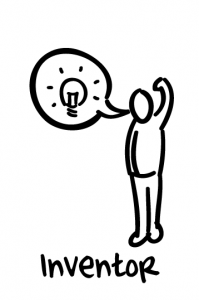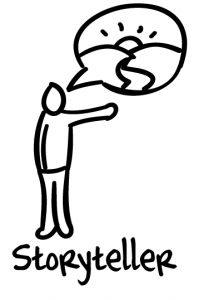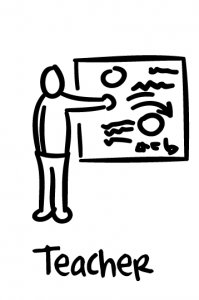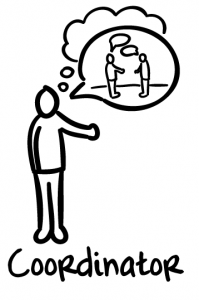How Does Your Presenter Type Build Relationships?
Gavin McMahon who blogs at Make A Powerful Point rocked my world with this blog post and his webinar about the 6 presenter types. I agree with his philosophy of embracing and getting to know YOU as a presenter. I loved his post so much that I asked to reblog. Gavin asked for one better – he asked me to supply commentary on each of the presenter types. I was flattered and happy to do so. Here are Gavin's 6 presenter types with color commentary by yours truly in italics about how each type builds relationships!
The 6 Presenter Types: Which one are you?
3 bullets on a slide. 1 slide per minute. Stand Still. Don’t fidget, memorize your slides. Now get up in front of a 100 people and do what I just told you. If you have been to Presentation training, you have probably heard many of these “Rules” before. You’ve been given the “right” way to present; the ONLY way to present. Yet it somehow feels like an unnatural act.
Over the last 10 years we’ve worked with thousands of clients in a range of industries. All of them know that if you want to get ahead, you have to be good on your feet. They’ve been to presentation seminars, Toastmasters and Dale Carnegie programs. From the most experienced CEO’s to the newest recruits, everyone’s secret wish is to be a better presenter, to nail that pitch or persuade one more person. Yet — and you know this in your heart — the general standard of presenting is very poor. Why? Pretty much everyone preaches one way to do it. And that’s just plain wrong.
There are 6 types of presenter. If you understand which one you are, if you understand where your strengths and weaknesses lie, you can get better. But the path forward is not the same for everyone.
Diagnose your presenter type. Take one minute to find your presenter type for fast-acting relief from PowerPoint pain.
Do the quiz before reading on. It's fast, and you'll learn something about yourself!
Is an energetic and personable speaker, who’s great at connecting and engaging people by doing and role-playing. They are better live than remote or over the phone. They usually very passionate about the topic and let that shine through. The Coach can quickly lose passion and enthusiasm with a low energy audience. They have a tendency to talk more than listen. May move too quickly for the audience, and not connect the dots for them. The Coach will dive right into building a deck and start with the slides that come easily. To practice, they go to a quiet place, pace up and down with a script, talk to themself to commit what they want to say to memory. Example: Rick Perry
Relationship building strength: They are natural connectors with an enthusiastic audience. They motivate their audience easily and grab their attention. The Coach really loves an engaged audience.
Relationship building weakness: Not all audiences are engaged. The low energy audience is the death knell for the Coach. The presentation becomes a slog, and they show they don't really care because the audience doesn't really care. To overcome this relationship building challenge, the Coach must meet their audience where they are at in that moment and slowly bring the audience to his or her energy level. If a Coach leads them gently in a presentation, the audience will follow. If the Coach shows his or her unbridled enthusiasm instead, the unengaged audience will stay that way!
Typically the last person to volunteer to make a public presentation, the Inventor is very good at connecting ideas for people and building logical sequences. They are usually much more comfortable once finished and working through a Q&A. The Inventor has difficulty holding large quantities of information in their head. They can get stuck searching for just the right word and worry about forgetting something important. The Inventor will start building a deck right away, by either writing a script or building slides. They start with key pieces. Building the deck gives them a firm grasp of the material so they tend not to practice much. They are very uncomfortable speaking off someone else’s work. Example: Steve Jobs
Relationship building strength: Q&A – it's all about the Q&A. Audiences love a presenter who takes time to answer their questions and give thoughtful responses. It shows the audience that the Inventor cares about them and has their best interest in mind.
Relationship building weakness: Q&A is typically at the end of the presentation. This means that the Inventor may lose their audience early on because they are more focused on finding the right word than connecting with people. The solution is to add Q&A throughout the presentation. Identify those points were it would be appropriate to stop and take questions. It breaks up the presentation and allows the Inventor to shine at what s/he is best at doing! Sir Richard Branson recently talked about his own fear of public speaking and how he uses Q&A in his presentations. I bet Sir Richard is an Inventor!
An eloquent speaker who likes to talk about ideas. The Counselor has an accurate and organized talk track, and a relentless stream of logic that’s easy to follow. They can move easily between big picture and detail. The Counselor can make the same presentation to an empty room as a large audience. They may fail to connect to and engage with the audience. Can be very dry and clinical. They tend to use big words where they aren’t required. The counselor builds by pulling slides together from previous decks, sequencing and re-sequence slides to feel comfortable with the flow and structure. Example: Barack Obama
Relationship building strength: The Counselor is easy to follow and has a well-organized presentation. The organization and the quality of content show the audience the Counselor cares about them because s/he prepared.
Relationship building weakness: That whole failing to connect and engage with the audience thing! Having great material that is well organized is awesome, but the next step is working on building a relationship with the audience. Particularly important is conducting an audience analysis- understanding who the audience is and what are their challenges means the counselor can tailor the material to the audience to show that s/he cares about the audiences wants and needs. To help with audience analysis read the 3 Questions to Ask to Connect.
A natural storyteller who speaks with feeling and rhythm. They can win an audience over easily. They use powerful and emotive words typically organized around what needs to get done. They add depth and detail through story and experience. By embellishing and adding detail to the story, the storyteller can lose the structure and flow for the audience. They tend not to track to slides, confusing the audience. Find it difficult to dry run well in front of empty rooms. The Storyteller prefers someone else to build their slides. This process can have a lot of stops and starts as they sort in their own mind what they want to say. These short monologues and conversations with the mini-audience prior to the big show is the way the storyteller practices. Examples: Newt Gingrich, Mike Huckabee.
Relationship building strength: Audiences love stories. It’s an engaging way of presenting information and allows the audience to see themselves in the presentation. Great way of building connection!
Relationship building weakness: The audience loves a Storyteller, but often times leaves the room less than satisfied because they are not sure what the message of the presentation was! The Storyteller needs to be clear on what their carry-out message is of their talk. Audience feedback is crucial. After a presentation, a Storyteller should ask the audience what they took away from the presentation. If they don’t know or come up with something that was not the planned message, some rewriting should be done to make the meaning of a story crystal clear to the audience.
Can easily get complex ideas across. They use a lot of figures of speech and metaphors. They are well structured speakers, who have the ability to carry a long talk-track in their head. The Teacher cares more about their material than the people in the audience. They may inadvertently disconnect from their audience, missing non-verbal cues and become distant. Visuals they use may be overly complex “wiring diagrams.” The Teacher starts with an outline and builds a talk-track off it. They tend to builds decks in a logical order and use visuals to illustrate ideas and points. Examples: Mitt Romney, Al Gore.
Relationship building strength: The ability to get complex ideas and material across is always a strength that an audience likes. It makes the audience feel smart, and that they are tracking right with the teacher. The audience also feels like they are learning which makes the presentation valuable.
Relationship building weakness: Disconnecting from the audience is the biggest stumbling block for the Teacher. They need a reminder that “Hey there are people out there”. I wrote a blog post about how adapting to your audience on the fly by keeping the audience NEAR (notice emotions, examine nonverbal communication, ask questions &request feedback). The Teacher would do well to keep this checklist in mind.
Prefers to be in the audience rather than the presenter, they nevertheless give organized, well-structured presentations, moving and gesturing as they speak. Their slides are visually meticulous and trigger a well thought out talk-track. The Coordinator is less comfortable speaking, but prefers working through their material than in a freeform Q&A environment. They are not comfortable working off others material. The Coordinator starts with an outline and builds key points, usually reflecting personal experience. They then prepare and sequence their deck.
Relationship building strength: Every audience wants a presenter to succeed! Even though the Coordinator does not want to be speaking and may even have a lot of anxiety, s/he is trying their best and the audience does appreciate it.
Relationship building weakness: Since the Coordinator takes so much time creating amazing PowerPoint slides and would rather be viewing those slides from the audience, there is a tendency for the coordinator to hide behind those well-designed slides. Avoid using slides as a teleprompter and making more eye contact with the slides than s/he does with the audience!
Everyone has natural strengths and weaknesses when it comes to presenting, yet most people use PowerPoint in a way that exaggerates their weaknesses instead of playing to their strengths. One size does not fit all, and following a set of “rules” that would work well for an inventor won’t work for a storyteller. What are you?
For the record, I am a storyteller which didn’t surprise me. What did surprise me was how well my type nailed the fact that I have a hard time practicing by myself! It explains why I really have to talk myself into practicing, but also while I practice to no one – I tend to get very judgmental about my presentation “Man, this sucks. No audience will like this.” Thanks to Gavin I learned to stop my negative self-talk while practicing because I know what is causing it!
What is your presenter type? Leave it in the comments below!
Merci Beaucoup to Gavin for allowing me to post his article and comment on it. You can find the original article here, but I highly recommend you either watch his free webinar or download the slideshare for more information on your presenter type.







Apparently I am a teacher. Which I knew and is awesome. Except for that I speak like Mitt Romney. What?!?
You’ve got charisma that Mitt Romney only wishes he has! Think about Mitt in that you connect to your audience and use PowerPoint in similar way. Does that make it better!?
Reading the Presenter Types article was helpful in several ways as I figured out I’m both Coach & Story Teller and the challenges documented are certainly pain I’ve felt over the years. It’s helpfull to understand that we all have different challenges and I need to recruit help in various areas when needed to assist in particular scenarios instead of sweating out that I may not be the best pitch man for certain elements invovled with a particular presentation or audience. Good stuff. Thanks for sharing.
Thank you for your comment Bob! I agree you have to understand your unique strengths and weaknesses as a presenter and embrace those. If we can’t overcome a weakness, we can at least setup a presentation that will play to our biggest strengths. That is always the key – to understand what you do best – and do just that!
Interesting! According to the results, I am a Counselor. And yet as I read the descriptions, especially the strengths and weaknesses, it is clear I am a Storyteller. It’s not a matter of which one is “right,” of course, but rather the very useful insights to be gleaned from the process. Thanks!
I felt it totally nailed me – I am a storyteller. However, it might be like doing a Meyer-Brigg’s assessment – you need to find the best fit and not just do the online assessment!